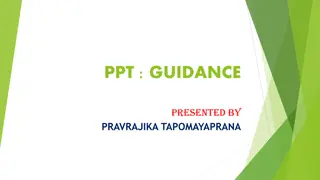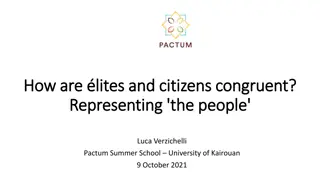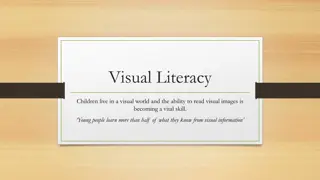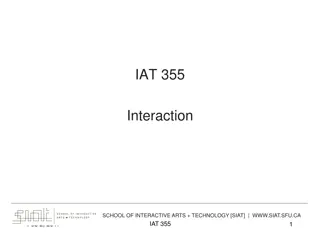Customize Your FLW Inventory Description Graphic
Learn how to customize a template to graphically represent the scope of an FLW inventory using the FLW Standard. This set of slides provides guidance on customizing material types, destinations, and other dimensions of scope to accurately describe your FLW inventory. Get hands-on tips for editing the graphic and showcasing the details of your inventory effectively.
Download Presentation

Please find below an Image/Link to download the presentation.
The content on the website is provided AS IS for your information and personal use only. It may not be sold, licensed, or shared on other websites without obtaining consent from the author. Download presentation by click this link. If you encounter any issues during the download, it is possible that the publisher has removed the file from their server.
E N D
Presentation Transcript
HOW TO USE THIS SET OF SLIDES The FLW Standard provides consistent language for describing the scope of an FLW inventory We have created a template to graphically show the 5 dimensions of scope (including possible components of material type and destinations ) These slides show you how to customize this template and create a graphic that you can use to easily describe your scope using the FLW Standard Also included in this set of slides are a few samples of FLW inventories, showing how others have used this template to describe their scope
TEMPLATE for you to customize Food Food category = (insert text) Pre-harvest losses and the weight of product packaging is excluded from the weight of FLW. Animal Feed (insert timeframe) Inedible parts Biomaterial/ processing Lifecycle stage = (insert text) Co/anaerobic digestion Compost/aerobic (modify and/or insert additional relevant text) See Slides 3 & 4 for instructions on how to customize this template to show your scope Geography = (insert text) Controlled combustion Land application Organization = (insert text) Landfill Not harvested Refuse/discards Sewer
HOW TO EDIT GRAPHIC 1. MATERIAL TYPES AND DESTINATIONS Color in the boxes for material type(s) and destination(s) that are included. TO COLOR A BOX: 1. Select shape, go to Format 2. Go to Shape Fill and select Gold, lighter 80% from Theme colors 3. Go to Shape Outline and select Green from Theme colors 4. Make edits to relevant text. Highlight text and select Black from Font colors Animal Feed TO GREY-OUT BOX IF NEEDED/NOT SELECTED: 1. Select shape, go to Format 2. Go to Shape Fill and select No Fill or White from Theme colors 3. Go to Shape Outline and select Grey from Theme colors 4. The text uses the same Grey as the shape outline Inedible parts 2. CHECKMARK Use check mark only for colored boxes (for material types and destinations) This symbol can be copy & pasted for reuse. You can also adjust the color. For example, if a destination is included in the scope of the inventory but no FLW goes to that destination, you may change the color of the check mark for that destination to be beige.
MORE GUIDANCE ON HOW TO CUSTOMIZE THE GRAPHIC FOR YOUR SCOPE Make the relevant changes to the 5 dimensions of scope. For definitions and additional guidance, refer to the Appendix of this file and Chapter 6 of the FLW Standard. For details on editing the graphic, see slide 3 1.TIMEFRAME (Add text) 2.MATERIAL TYPE(S) a. If material is included; color in box b. Use check mark only for colored boxes 3. DESTINATION(S) a. If material is included; color in box b. Use check mark only for colored boxes 4. BOUNDARY (Add text) 5. RELATED ISSUES (Edit text if relevant, e.g., edit to describe if calculation was needed to separate weight of packaging from FLW)
SAMPLE CUSTOMIZED GRAPHIC Scope of Proposed European Commission Definition of Food Waste Food category = All food and beverages Food 12 months (January 1 December 31) Pre-harvest losses and the weight of product packaging is excluded from the weight of FLW Inedible parts Co/anaerobic digestion Lifecycle stage = All (only includes farm-level FLW that s off site) Compost/aerobic Controlled combustion Geography = Entire country Land application Landfill Organization = All FLW-producing units Not harvested Refuse/discards Sewer
THIS IS THE TEMPLATE GRAPHIC WITH ALL BOXES COLORED IN (I.E., ALL MATERIAL TYPES AND DESTINATIONS HAVE BEEN SELECTED) Pre-harvest losses and the weight of product packaging is excluded from the weight of FLW. Food Food category = (insert text) Animal Feed (insert timeframe) Inedible parts Biomaterial/ processing Lifecycle stage = (insert text) Co/anaerobic digestion Compost/aerobic (modify and/or insert additional relevant text) Geography = (insert text) Controlled combustion Land application Organization = (insert text) Landfill Not harvested Refuse/discards Sewer
Definitions for Scope from the FLW Standard
DEFINITION: MATERIAL TYPES Defining Food and Inedible Parts Food:a Any substance whether processed, semi-processed, or raw that is intended for human consumption. Food includes drink, and any substance that has been used in the manufacture, preparation, or treatment of food. Food also includes material that has spoiled and is therefore no longer fit for human consumption. It does not include cosmetics, tobacco, or substances used only as drugs. It does not include processing agents used along the food supply chain, for example, water to clean or cook raw materials in factories or at home. Inedible parts: Components associated with a food that, in a particular food supply chain, are not intended to be consumed by humans. Examples of inedible parts associated with food could include bones, rinds, and pits/stones. Inedible parts do not include packaging. What is considered inedible varies among users (e.g., chicken feet are consumed in some food supply chains but not others), changes over time, and is influenced by a range of variables including culture, socio-economic factors, availability, price, technological advances, international trade, and geography. aAdapted from Codex Alimentarius Commission (2013)
DEFINITION: DESTINATIONS Destination Definition Diverting material from the food supply chaina (directly or after processing) to animals Animal feed Bio-based materials/biochemical processing Converting material into industrial products. Examples include creating fibers for packaging material, creating bioplastics (e.g., polylactic acid), making traditional materials such as leather or feathers (e.g., for pillows), and rendering fat, oil, or grease into a raw material to make products such as soaps or cosmetics. If the outputs from this destination are biofuel products (e.g., biodiesel, fuel pellets), or unknown, the material shall be included in the Other destination. Biochemical processing does not refer to anaerobic digestion or production of bioethanol through fermentation. Codigestion/anaerobic digestion Breaking down material via bacteria in the absence of oxygen. This process generates biogas and nutrient-rich matter. Codigestion refers to the simultaneous anaerobic digestion of FLW and other organic material in one digester. This destination includes fermentation (converting carbohydrates such as glucose, fructose, and sucrose via microbes into alcohols in the absence of oxygen to create products such as biofuels) Composting/aerobic processes Breaking down material via bacteria in oxygen-rich environments. Composting refers to the production of organic material (via aerobic processes) that can be used as a soil amendment Controlled combustion Sending material to a facility that is specifically designed for combustion in a controlled manner, which may include some form of energy recovery (this may also be referred to as incineration) Spreading, spraying, injecting, or incorporating organic material onto or below the surface of the land to enhance soil quality Land application Landfill Sending material to an area of land or an excavated site that is specifically designed and built to receive wastes Not harvested/plowed-in Leaving crops that were ready for harvest in the field or tilling them into the soil Refuse/discards/litter Abandoning material on land or disposing of it in the sea. This includes open dumps (i.e., uncovered, unlined), open burn (i.e., not in a controlled facility), the portion of harvested crops eaten by pests, and fish discards (the portion of total catch that is thrown away or slipped) Sewer/wastewater treatment Sending material down the sewer (with or without prior treatment), including that which may go to a facility designed to treat wastewater Other Sending material to a destination that is different from the 10 listed above. This destination should be described a Excludes crops intentionally grown for bioenergy, animal feed, seed, or industrial use
DEFINITION: BOUNDARY Boundary dimension Definition Examples All food Dairy products Fresh fruits and vegetables Chicken Entire food supply chain Two stages: manufacture of dairy products, and retail of food and beverage At home World (all countries) Eastern Asia Ghana Nova Scotia, Canada Lima, Peru All sectors in country Entire company Two business units All 1,000 stores 100 households Food category The type(s) of food included in reported FLW Lifecycle stage The stage(s) in the food supply chain or food lifecycle within which reported FLW occurs Geography Geographic borders within which reported FLW occurs Organization Organizational unit(s) within which reported FLW occurs
BOUNDARY (Classification sources to use) Boundary dimension Classification source to use (select the most current version) Select one or more categories from either the Codex General Standard for Food Additives (GSFA) system or United Nations Central Production Classification (CPC) system If more detailed information is used, include appropriate codes from more granular sources including: Global Product Category (GPC) codes(online, or download an Excel, Word or XML copy) United Nations Standard Products and Services Code (UNSPSC) Selected examples with relevant codes All food (GSFA 01.0 16.0) or (CPC2.1 Divisions 21 24) Dairy products (GSFA 01.0) or (CPC2.1 Group 221 & 222) Fresh fruits and vegetables (GSFA 04.1 & 04.2.1) or (CPC2.1 Group 012 & 013) Chicken (GSFA 08.1.1 [Fresh meat, poultry, and game, whole pieces or cuts]; GPC Brick 10005769) or (CPC2.1 Subclass 21121) Food category Select one or more United Nations International Standard Industrial Classifications of All Economic Activities (ISIC) codes(At the time of publication, the latest version is Rev.4 ) Regional and national classification systems may be used as well, most of which are derived from the ISIC (e.g., NACE for Europe). The UN Statistics Division lists national classification systems If no code exists, write in the lifecycle stage Entire food supply chain (select relevant group of ISIC codes) Two stages: manufacture of dairy products (ISIC Group: 105) and retail of food and beverage (ISIC Class: 4721) At home (ISIC Class: 9820) Lifecycle stage Select one or more UN regions or country codes Write in description for narrower geographic scope. Where available, use a national classification system (e.g., U.S. Census) World/all countries (UN Code 001) Eastern Asia (UN Code 030) Ghana (UN Code 288) Nova Scotia, Canada Lima, Peru All sectors in country Entire company Two business units All 1,000 stores 100 households Geography Write in number and type of unit(s) and any additional descriptive detail Organization
FLW STANDARD ACCOUNTING AND REPORTING REQUIREMENTS 1. Base FLW accounting and reporting on the principles of relevance, completeness, consistency, transparency, and accuracy 2. Account for and report the physical amount of FLW expressed as weight (e.g., pounds, kilograms, tons, metric tons) 3. Define and report on the scope of the FLW inventory a. Timeframe. Report the timeframe for which the inventory results are being reported (including starting and ending date) b. Material type. Account for and report the material type(s) included in the FLW inventory (i.e., food only, inedible parts only, or food and associated inedible parts). If food or associated inedible parts removed from the food supply chain are accounted for separately in the inventory: Describe the sources or frameworks used to categorize a material as food or as inedible parts. This includes stating any assumptions that were used to define whether or not material was intended for human consumption Describe the approach used to calculate the separate amounts. If applicable, describe all conversion factors used and their sources c. Destination. Account for and report the destinations included in the FLW inventory (i.e., where material removed from the food supply chain is directed). If the destination is unknown, then report the initial path(s) at a minimum. d. Boundary. Report the boundary of the FLW inventory in terms of the food category, lifecycle stage, geography, and organization (including the sources used to classify them). e. Related issues. Packaging and other non-FLW material. Exclude from an FLW inventory any material (and its weight) that is not food or associated inedible parts removed from the food supply chain (i.e., FLW). If a calculation is needed to separate the weight of FLW from non-FLW materials (e.g., subtracting the weight of packaging), describe the approach and calculation used Water added/removed from FLW. Account for and report the weight of FLW that reflects the state in which it was generated before water was added, or before the intrinsic water weight of FLW was reduced. If a calculation is made to estimate the original weight of FLW, describe the approach and calculation used Pre-harvest losses. Exclude pre-harvest losses from the scope of an FLW inventory. Users may quantify such losses but shall keep data separate from the FLW inventory results 4. Describe the quantification method(s) used. If existing studies or data are used, identify the source and scope 5. If sampling and scaling of data are undertaken, describe the approach and calculation used, as well as the period of time over which sample data are collected (including starting and ending dates) 6. Provide a qualitative description and/or quantitative assessment of the uncertainty around FLW inventory results 7. If assurance of the FLW inventory is undertaken (which may include peer review, verification, validation, quality assurance, quality control, and audit), create an assurance statement 8. If tracking the amount of FLW and/or setting an FLW reduction target, select a base year, identify the scope of the target, and recalculate the base year FLW inventory when necessary
STRUCTURE OF THE FLW STANDARD (PARTS I, II, III) PART I. Overview 1. Introduction 2. Definition of terms and applications 3. Goals of quantifying FLW 4. Summary of steps and requirements 5. Principles of FLW accounting and reporting PART II. Main requirements 6. Establishing the scope of an FLW inventory 7. Deciding how to quantify FLW PART III. Other requirements and recommendations 8. Collecting, calculating, and analyzing data 9. Assessing uncertainty 10. Coordinating the analysis of multiple FLW inventories 11. Recording causes of FLW 12. Review and assurance 13. Reporting 14. Setting targets and tracking changes over time
STRUCTURE OF THE FLW STANDARD (APPENDIX) & GUIDANCE ON FLW QUANTIFICATION METHODS Appendix to the FLW Standard A. Approaches to sampling and scaling up data B. Separating material types: data sources for conversion factors applied to individual items C. Normalizing data D. Expressing weight of FLW in other terms or units of measurement E. Quantifying and reporting the weight of food rescued Guidance on FLW Quantification Methods (stand-alone document) Introduction 6. Diaries 7. Surveys 8. Mass balance 9. Modeling 10. Proxy data Quantification Methods 1. Direct weighing 2. Counting 3. Assessing volume 4. Waste composition analysis 5. Records Appendix: Quantifying FLW if water is added























